In January I wore a NutriSense CGM to monitor my blood glucose. I was gifted the two week experience, but this post is not sponsored. My code, AHS25, will get you $25 off if you are looking to try it yourself.
My mom and I geek out over health together. We listen to the same podcasts, debate best foods for our bodies, and pour over our bloodwork results. It’s our strange kind of fun. When we first learned about continuous glucose monitors (CGM) a couple years ago, we put it on our radar to try together at some point. Growing research shows that blood sugar control has a sincere impact on our health and a CGM allows you to track in real time how different factors (foods, drinks, stress, sleep, exercise, etc) impact your blood sugar.
For the past two weeks, mom and I wore NutriSense CGMs. This is my honest assessment of the experience.
What is a CGM?
A continuous glucose monitor (CGM) works through a tiny sensor inserted under your skin (NutriSense’s monitor goes on the back of your arm). The sensor measures your interstitial glucose level, which is the glucose found in the fluid between the cells. The sensor tests glucose every few minutes and wirelessly sends the information to the app on your phone when you scan.
Why did I want to try it?
This was the question I was asked most- as a non diabetic, why would I want to track my blood sugar? The short answer is that blood sugar control affects us all and has an impact on our health from how we feel to how well we sleep to deeper health issues we can’t necessarily feel the impact they’re having on our health.
The long story is that I have a long history of blood sugar issues. 15 years ago I had to keep a granola bar next to my bed to eat first thing upon waking because if I waited even 30 minutes to eat breakfast I’d feel light headed and nauseated- a sign of poorly managed blood sugar. When I was pregnant with Hailey I failed my glucose test then went on to pass out and throw up all over myself during my three hour test.
I started learning more about balancing blood sugars during pregnancy and had a good start on the basics- check out this 2015 post about how I was working on balancing my blood sugar with food.
Since then I’ve learned more about what works best for my body after experimenting with basically being vegan for over a year and seeing how much that messed with my hormones. Then taking the steps necessary to correct it.
For the past year or two now I feel like I have a good handle on my blood sugar and how to control it, at least for me. So trying the CGM was more for curiosity sake (am I doing as well as I think I am?) and for experimental purposed (if I just eat a slice of sourdough and butter, will it spike me?).
There are a lot of resources online now to see CGMs in action (the Glucose Goddess shares a plethora of CGM results and awesome tips for example- her book is on my radar to read), but since results can be vary slightly person to person, I wanted to see first hand how I reacted.
NutriSense CGM Application and Experience
One thing I was most nervous about was the application and wearing of the device. Like a lot of the population, I’m not a fan of needles. The set-up is that the applicator quickly punctures the skin with a tiny needle, then leaves a filament behind to monitor your blood sugar. The application was easy to implement and I was happily surprised to discover it wasn’t uncomfortable. You then cover the monitor with a provided waterproof patch. The patch lasted me the duration of the two weeks easily, even through showers, though the edge of it withered slightly.
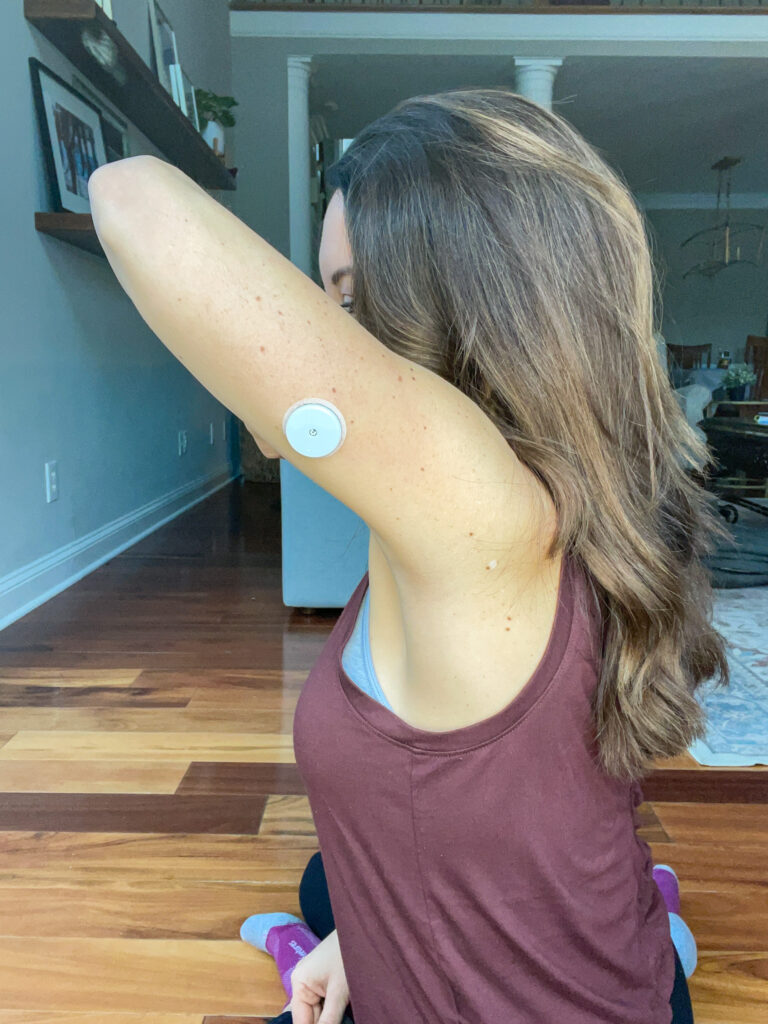
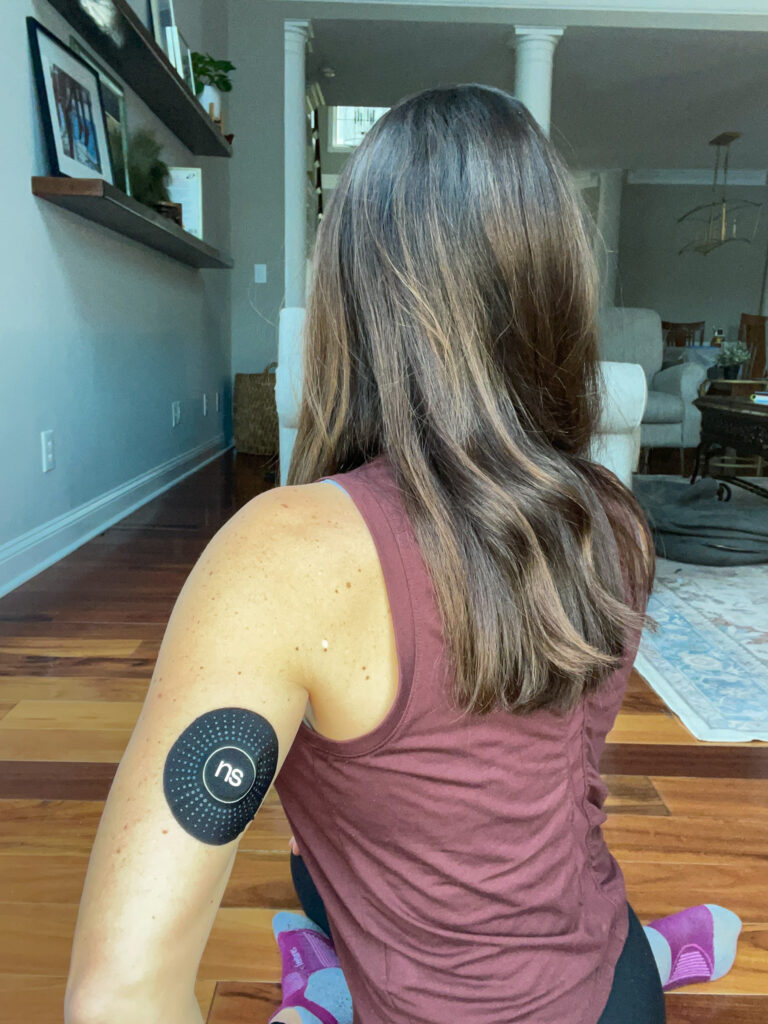
From there, you wirelessly connect your CGM with your app and you’re off the races. You log your meals and exercise (my exercise logged automatically; I’m thinking it was through the apple watch?). You then scan to get your blood sugar results at least every 8 hours, through I did it far more often than that. To scan, you simply open the app, hit the scan button, then touch your phone to your CGM. It’s instant!
Over the two weeks I enjoyed checking in on my data. A lot of what I have learned about controlling blood sugar proved to be true. I had to branch out a bit though because I at first I felt like I was playing a game to see how well controlled I could keep it. While fun for my competitive nature, I wanted to use this time to experiment, like seeing how just carbs would effect me, how certain drinks would effect me, how the order of what I ate effected me, and if I could feel it when I spiked. So the second week I played around a bit more with foods, drinks, and habits I wasn’t quite so sure of.
The subscription comes with unlimited access to a RD assigned to help you navigate your results. At first I felt like I wouldn’t need this much, but it turned out to be incredibly valuable to have a trained professional there to help me interpret my data. She was able to give me tips and I loved having someone to answer the questions- how much of a spike is too high? Is this a normal level to see overnight? Is it possible stress effected my blood sugar here?
Personal Results
My biggest takeaway from the experience was confirmation that I have learned over the years how to best control my blood sugar well through lifestyle and diet… though I don’t always necessarily play by those rules. Seeing the results of my healthier and not as healthy choices was motivating.
A few surprises for me included learning that we will have a glucose response to almost anything we eat unless it’s pure fat, so it’s the height of the spike (you want it less than 30) that matters more rather than aiming for no rise. I also was surprised to learn the spike takes place not immediately after eating, but generally closer to about an hour afterwards.
My biggest spike was when I started a meal with a Hazy IPA beer- it SHOT UP, even more so than when I ate Tres Leches cake on an empty stomach.
I loved that after 14 days, I was sent a wrap-up of my results. Here’s a peek:
- Daily average: 99 mg/dL (goal <105)
- Max glucose: 178 mg/dL (goal <140) -the hazy IPA
- Standard Deviation: 14 (goal <14)
- Time within Range: 98 (goal >95%)
- Morning average: 91 mg/dL (goal 70 – 90)
- Sleep average: 93 mg/dL (goal <105)
Morning average might be skewed a bit, especially if you ate or drank earlier than 8am. *my morning average was probably skewed because I always had coffee with heavy cream, but forgot to enter it into my food log.
Personal takeaways:
- Processed carbs, even when paired with protein and fat, spike my blood sugar. I tried my favorite restaurant’s buffalo chicken wrap twice and both times the wrap sent it way up. Siete tortillas made with almond flour, however, didn’t spike me at all.
- Wine and beer spike my blood sugar; vodka does not.
- A walk after a higher carb meal helps my body to reduce blood glucose levels quickly.
- The best order to eat foods is: fiber first, then protein and fat, then carbs.
- Eating my last meal a few hours before bed really gave my glucose time to come down and have healthy overnight levels.
- Getting enough sleep had a positive impact on my glucose levels. One night I slept pretty rotten and my glucose was elevated slightly the whole next day.
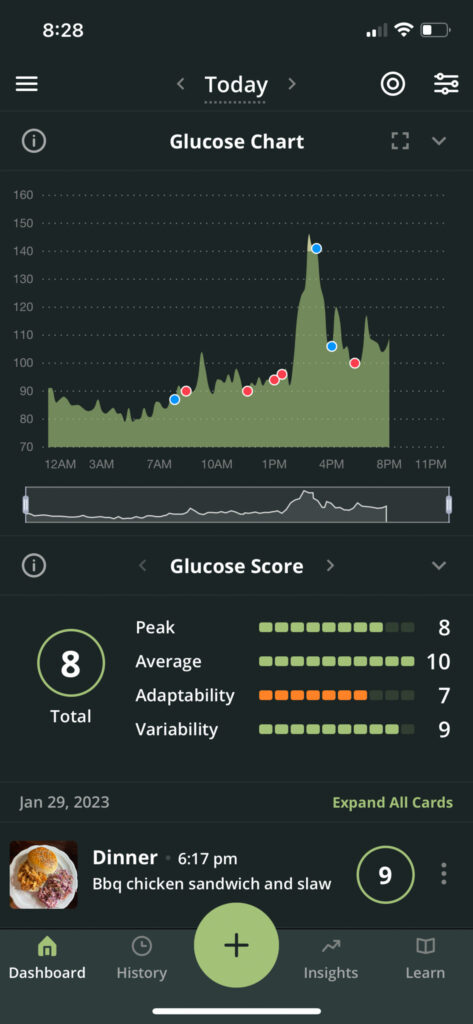
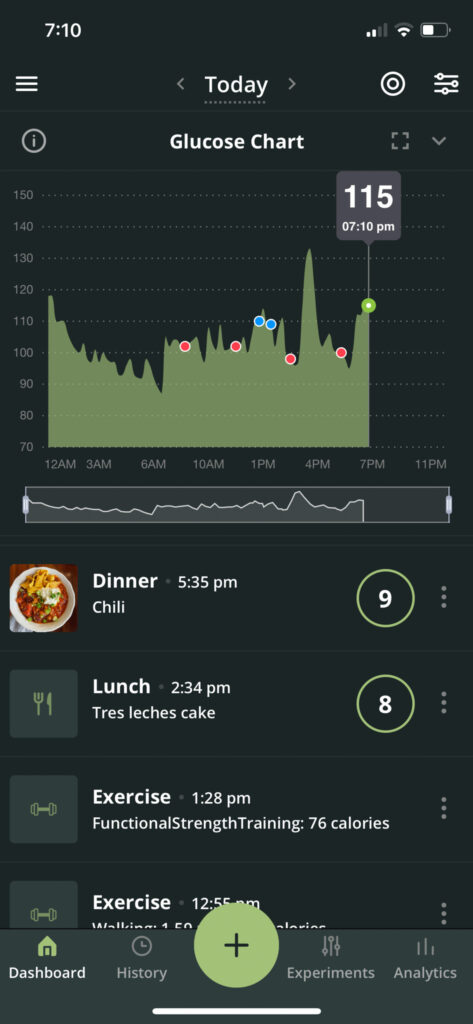
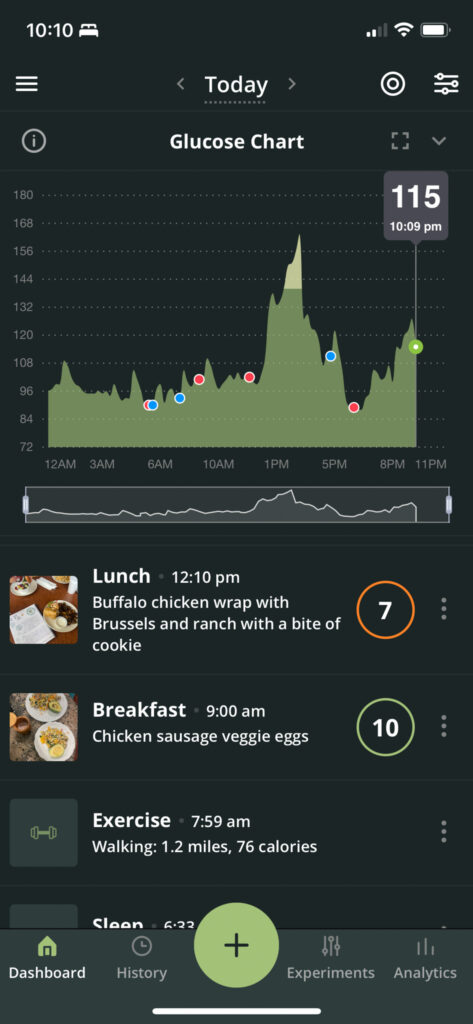
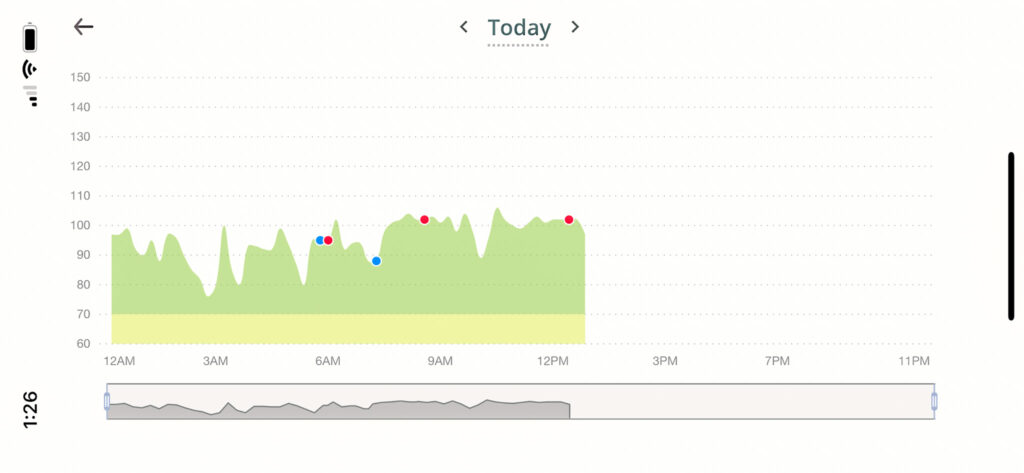
Q&A
Along the journey I asked for questions about the experience and collected a few for me and a few to pass along to Mia, my personal glucose guru RD who monitored me. I hope these are helpful!
For me:
What was your biggest surprise? Do you think it’s worth it?
My biggest surprise is that the sensor didn’t bother me at all. I was worried about sleeping or having it irritate my skin, but I honestly forgot about it.
The “is it worth it” question is so personal. For me, yes, being able to collect that kind of personal health data it was worth it. I’m looking at signing David up for a round at some point, too. I’m a believer that knowledge is power and trying to optimize health for feeling my best and for longevity is a top priority for me.
Will you change anything in your diet after using the CGM?
I won’t change anything major, but I will definitely be more mindful. For example, when cooking, I often take little bites of whatever I’m making or snack on pretzels, but now I’ve seen the proof that even those little bits impact blood sugar and start to spike it before I’ve had my meal. It really is best for my health to not snack along the day, but rather to have meals, then let my digestion rest.
Do you notice symptoms when you spike?
I didn’t, which was a bit surprising. However, if it dropped below 80, I would feel shaky/moody.
For Mia the RD:
Why would someone who isn’t diabetic want to do this?
Testing glucose does not need to be tied to a formal diagnosis. Instead, it can be thought of as a window of insight into the body, like temperature, heart rate, and respiratory rate. It is impacted by sleep, food, exercise, stress, and other factors. Monitoring glucose with a CGM enables people to have real-time knowledge of their body’s unique responses and provides insight for the creation of tailored health solutions. You can build a personalized diet and lifestyle around data-driven results.
CGMs empower those who have no formal diagnosis of glucose intolerance. The goal is to decrease the likelihood of developing metabolic diseases, such as heart disease and diabetes and help people live healthier, happier lives!
A CGM provides real time data and feedback
Will glucose go up if you’re in a stressful situation?
Stress has a profound impact on our glucose values. When our body or mind is under stress, it’s perceived as a threat. The body copes with threats by doing two things: 1) increasing glucose output/release from the liver, and 2) reducing insulin sensitivity. These two things combined can cause more glucose to stay in the blood, an important strategy in case we actually needed that energy as fuel to run from the threat (say if that threat was a lion). This response is evolutionary and incredibly important, but the type of stressors we have today don’t necessarily require this additional fuel. The result can be higher glucose values consistently as well as just in the moment.
Does it calculate your average blood sugar?
Yes. The CGM calculates your mean and median blood glucose value, the time you spend within the range of 70-140mg/dL, your highest peaks and lowest value, standard deviation or glycemic variability, your sleep average and your morning average.
Is glucose response very individual?
Yes. Each person has their own unique response to foods, stress and workouts.
I was prediabetic when I was pregnant; should I be worried about this?
Our scope of practice does not include diagnosing prediabetes or diabetes. If you are concerned about your numbers check with your doctor about getting a fasting glucose value, fasting insulin and a1c value drawn. You’re welcome to wear a CGM and monitor your current values and share them with your physician as well.
Why this instead of pricking your finger?
Both the CGM device and the finger prick devices are allowed by the FDA to have some variation from what you would receive from a full lab draw at a physicians office. The most important thing to consider is the overall trends rather than an exact number. For example, how much you increased after eating and how soon you return to pre-meal values. The change in glucose is very precise and reflects real changes. Wearing a CGM provides you with continuous data versus a finger prick that only provides a snapshot in time.
What is the cost and what do you do with the info afterwards?
Nutrisense offers 3, 6, and 12-month programs ranging from $225.00 to $299.00 per month depending on subscription length and upfront commitment.
All Nutrisense CGM programs include 1 month of complimentary dietitian coaching through our in-app chat messenger. Your dietitian will work with you towards your own unique health goals and provide feedback in real time.
Alongside the CGM and dietitian coaching, NutriSense gives you the option to track your meals, sleep, exercise, and stress, to paint a more complete picture of your health.
How does Nutrisense compare against other CGM companies?
The NutriSense program is designed to meet people where they are. It is designed to provide them insights, tools, and skills to help them reach their goals. We work with various health goals, from insulin resistance to weight loss to autoimmune conditions to cancer recovery and more. You will fill out a goals questionnaire, which your dietitian uses to help you achieve your individual goals and give you the tools to create sustainable lifestyle changes.
Our goal is to educate people on their glucose and how their food and lifestyle choices impact their levels. Our programs are designed to be tailored to individuals with a variety of needs.
The app can be integrated with Google Fit and Apple health so it automatically sync any sleep or activity data you log in other apps (this is where information from fitness trackers is integrated) These activities will plot along your graph in dots to help correlate activities and your glucose levels.
Do you need a prescription to attain this?
NutriSense takes care of the medical prescription for all our members, you do not need a prescription in advance of signing up for the program. The member base we currently serve normally requires a medical prescription to obtain a continuous glucose monitor (CGM). We understand how difficult it can be and take care of this for you!
How long do you wear it for?
Each sensor lasts for 14 days and is to be worn on the back of the arm.
If you have questions not answered, please leave a comment. Mia or I will be happy to answer it for you. I hope this was a helpful look into the NutriSense CGM experience!
